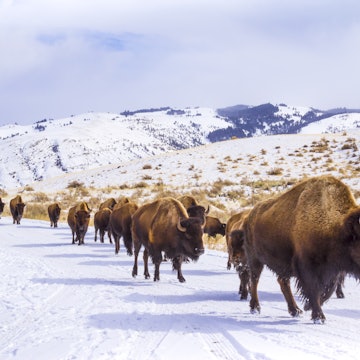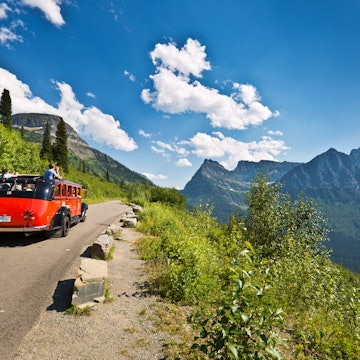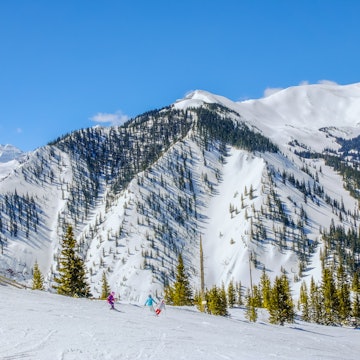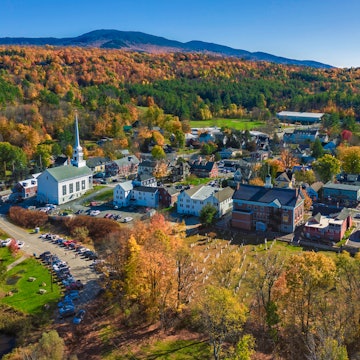
Why winter is the perfect time to spot Yellowstone’s wildlife

Nov 23, 2020 • 6 min read

Seeing a wolf in its natural environment can be an amazing experience © judilen / Getty Images
Geothermal wonders and stunning landscapes have drawn visitors to Yellowstone National Park for almost 150 years, but there’s never been a better time to discover how the park turns into a wildlife wonderland during the winter.
Among the sparkling, crystalline snow the world may appear to be still, but for those who know how to listen, life is clearly thriving in Yellowstone. Alarm calls from crows resonate from tree to tree, notifying other birds when foxes are hunting nearby. As if running from the cold, a hidden river gurgles beneath solid sheets of ice.
Then, a lone howl pierces the crisp, frigid air, its melancholy drone echoing through the valley until a chorus of responses transforms silence into symphony. There are wolves nearby. And the birds aren’t the only ones with a lot to say about it.
Editor's note: during COVID-19 there are restrictions on travel, and some areas are under lockdown. Check the latest guidance before departure, and always follow local health advice.

Historic wolf reintroduction
There is almost nowhere in the US where wolves can be spotted in the wild. Before colonization, America was a nation of wolves. At their peak, there were up to 500,000 of the apex predators living in balance with the other creatures of the land (humans included). They lived in every corner of North America, besides present-day California’s coast. But by the 1960s systematic killing reduced the lower 48 states’ wolf population to only 300. Myths of the wolf’s treachery fueled bounty hunters and vengeful ranchers, and the hatred these stories fostered ultimately made wolf conservation a political challenge.
But in 1995, grassroots efforts won out, and 31 Canadian gray wolves were brought to Yellowstone in an attempt to reintroduce the species to its historic habitat, resulting in what is likely the world’s most famous wildlife reintroduction. A video describing how the reappearance of wolves in Yellowstone after a 70-year absence changed its rivers went viral in 2014, and suddenly public opinion shifted to recognize the importance and the fragility of this ecological paradise.
Yellowstone National Park is known for its prismatic pools and gushing geysers, incredible natural sights that not only inspired the creation of the National Parks System, but also attract more than four million visitors every year. Official statistics show 91 percent of those people visit between May and September, leaving the park virtually empty during the other months, particularly in the heart of winter.
Winter, however, is when Yellowstone is at its best – particularly for wildlife lovers. It isn’t just the lack of people, although that’s always a bonus when visiting any outdoor space. "It’s really breathtaking, to begin with," says Nathan Varley, one half of a husband-and-wife team guiding wildlife-watching excursions in the park through their business, Yellowstone Wolf Tracker. "It is kind of a winter wonderland, from big downy flakes of snow, or crystalline frost that sparkles in the air."
Varley and his wife, Linda Thurston, joined the wolf reintroduction effort in 1996. Today their expertise on wolves and other animals sharing the ecosystem helps Varley and Thurston consistently sell out their popular Winter Wolf Retreats. Attendees soon learn that even though the vast majority of visitors see Yellowstone in its summer clothes, the winter wildlife watchers are the ones reaping the benefits.

Watching wildlife against the snow
The Rocky Mountain weather may turn some off, but it’s a prominent factor in why animal watching is so fruitful in the winter.
"Wildlife is easily spotted against the white snow background," says zoologist and writer Cristina Garcia of Travel For Wildlife in her Yellowstone winter gear guide. Similarly, the snow drives bison, elk, and other grazing animals away from the high peaks and forces them to congregate in the valley bottoms.
"In Yellowstone the roads follow the valley bottoms, so there’s great access to the wildlife," adds Varley.
This means the average visitor to Yellowstone during the winter potentially won’t even need to leave the vicinity of their car to see a wild wolf and other critters. They are shy animals, rightfully wary of coming close to people, so most encounters will be from a distance. But it’s still a remarkable experience to see the ancient beauty of America firsthand.
It’s also the most interesting time to watch wolves. "They do a lot of howling in winter due to their social dynamics, traveling around as a big pack, making kills more often," says Varley. So not only are wolves more concentrated into viewable, drivable areas, they’re much more active. "That, and the breeding season happens in mid-winter, from the end of January through February, and that brings extra drama to wolf watching."

A vibrant Yellowstone ecosystem
It’s not only wolves making Yellowstone a wildlife hotspot: a wide range of species call Yellowstone home. Together they make up the largest concentration of mammals in the lower 48 states. There are silent mountain lions, playful river otters, fluffy coyotes, moose, Canada lynxes, pronghorn, red foxes and more.
Bison in particular draw the attention of photographers.
"The bison herds are persevering, transformed into these abominable snowmen where the snow sticks to their backs," Varley says. But it’s the wolf sightings getting people emotional, and it’s the wolves – the "pinnacle animal" as he calls them – bringing in the money.
Wolves are estimated to be worth between $70 and $100 million to the local economy, Varley says. That’s on top of money brought in from the overall tourism industry. "This is just the ones where we were able to identify wolves as being the significant factor in the decision to come to Yellowstone," he says.

Scoping things out: how to spot a wolf
When the snow comes, Yellowstone as a business basically shuts down, but life does not: bears are pretty much the only ones opting out of participating in winter activities. The weather closes a majority of the park, leaving only the north entrance from Gardiner, Montana, open.
The only open road goes from Gardiner to Mammoth Hot Springs, then past Tower Junction and onto the Northeast entrance, which is only an exit in winter. This may seem limiting, but it’s all a winter wolf-watcher needs: this is the road going right through the Lamar Valley, one of the top wolf-watching locations on the planet, and easily the most accessible.
If you go looking for wolves, bring a spotting scope or binoculars, plenty of patience, and warm clothes – you’ll need them to sustain what can be long periods of waiting. Temperatures frequently dip below zero in the daytime, but early morning (between 6am and 11am) is the best time to spot most Yellowstone animals, so plan for even colder.
Guides like Varley and Thurston can be hired along with their spotting equipment, as well as access to the network of professional conservationists, who radio one another with confirmed wildlife sightings.
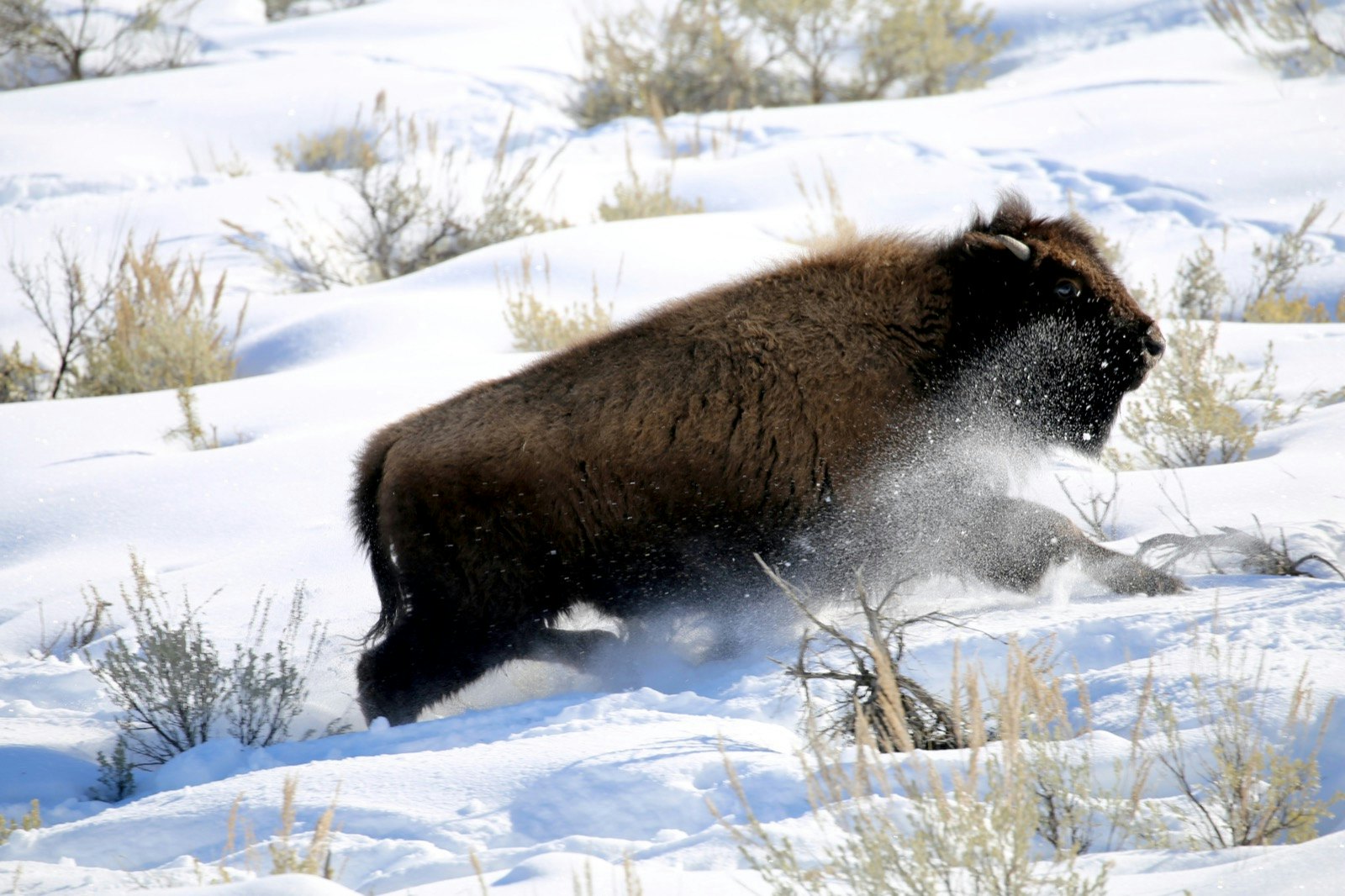
Know the odds of animal sightings
Wildlife spotting is notoriously challenging, but the odds don’t get better than Yellowstone in winter. With so many species leaving the planet permanently, the US is lucky to house a haven like Yellowstone National Park, where the animals not only thrive, but congregate near a single road for months on end.
There’s never a guarantee of seeing anything, but once in Yellowstone, there is no way to escape the call of the wild.
Updated November 2020.







